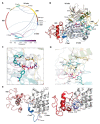The Inherent Coupling of Intrinsically Disordered Regions in the Multidomain Receptor Tyrosine Kinase KIT
- PMID: 35163518
- PMCID: PMC8835827
- DOI: 10.3390/ijms23031589
The Inherent Coupling of Intrinsically Disordered Regions in the Multidomain Receptor Tyrosine Kinase KIT
Abstract
RTK KIT regulates a variety of crucial cellular processes via its cytoplasmic domain (CD), which is composed of the tyrosine kinase domain, crowned by the highly flexible domains-the juxtamembrane region, kinase insertion domain, and C-tail, which are key recruitment regions for downstream signalling proteins. To prepare a structural basis for the characterization of the interactions of KIT with its signalling proteins (KIT INTERACTOME), we generated the 3D model of the full-length CD attached to the transmembrane helix. This generic model of KIT in inactive state was studied by molecular dynamics simulation under conditions mimicking the natural environment of KIT. With the accurate atomistic description of the multidomain KIT dynamics, we explained its intrinsic (intra-domain) and extrinsic (inter-domain) disorder and represented the conformational assemble of KIT through free energy landscapes. Strongly coupled movements within each domain and between distant domains of KIT prove the functional interdependence of these regions, described as allosteric regulation, a phenomenon widely observed in many proteins. We suggested that KIT, in its inactive state, encodes all properties of the active protein and its post-transduction events.
Keywords: allosteric regulation; conformational transition; free energy landscape; full-length KIT cytoplasmic region; intrinsically disordered regions; modelling; molecular dynamics; phosphotyrosine; receptor tyrosine kinase (RTK).
Conflict of interest statement
The authors declare no conflict of interest. The funders had no role in the design of the study; in the collection, analyses, or interpretation of data; in the writing of the manuscript, or in the decision to publish the results.
Figures









Similar articles
-
Does Generic Cyclic Kinase Insert Domain of Receptor Tyrosine Kinase KIT Clone Its Native Homologue?Int J Mol Sci. 2022 Oct 25;23(21):12898. doi: 10.3390/ijms232112898. Int J Mol Sci. 2022. PMID: 36361689 Free PMC article.
-
Folding and Intrinsic Disorder of the Receptor Tyrosine Kinase KIT Insert Domain Seen by Conventional Molecular Dynamics Simulations.Int J Mol Sci. 2021 Jul 9;22(14):7375. doi: 10.3390/ijms22147375. Int J Mol Sci. 2021. PMID: 34298994 Free PMC article.
-
The First 3D Model of the Full-Length KIT Cytoplasmic Domain Reveals a New Look for an Old Receptor.Sci Rep. 2020 Mar 25;10(1):5401. doi: 10.1038/s41598-020-62460-7. Sci Rep. 2020. PMID: 32214210 Free PMC article.
-
Structure and regulation of Kit protein-tyrosine kinase--the stem cell factor receptor.Biochem Biophys Res Commun. 2005 Dec 23;338(3):1307-15. doi: 10.1016/j.bbrc.2005.09.150. Epub 2005 Oct 4. Biochem Biophys Res Commun. 2005. PMID: 16226710 Review.
-
Signaling by Kit protein-tyrosine kinase--the stem cell factor receptor.Biochem Biophys Res Commun. 2005 Nov 11;337(1):1-13. doi: 10.1016/j.bbrc.2005.08.055. Biochem Biophys Res Commun. 2005. PMID: 16129412 Review.
Cited by
-
Does Generic Cyclic Kinase Insert Domain of Receptor Tyrosine Kinase KIT Clone Its Native Homologue?Int J Mol Sci. 2022 Oct 25;23(21):12898. doi: 10.3390/ijms232112898. Int J Mol Sci. 2022. PMID: 36361689 Free PMC article.
References
MeSH terms
Substances
LinkOut - more resources
Full Text Sources

